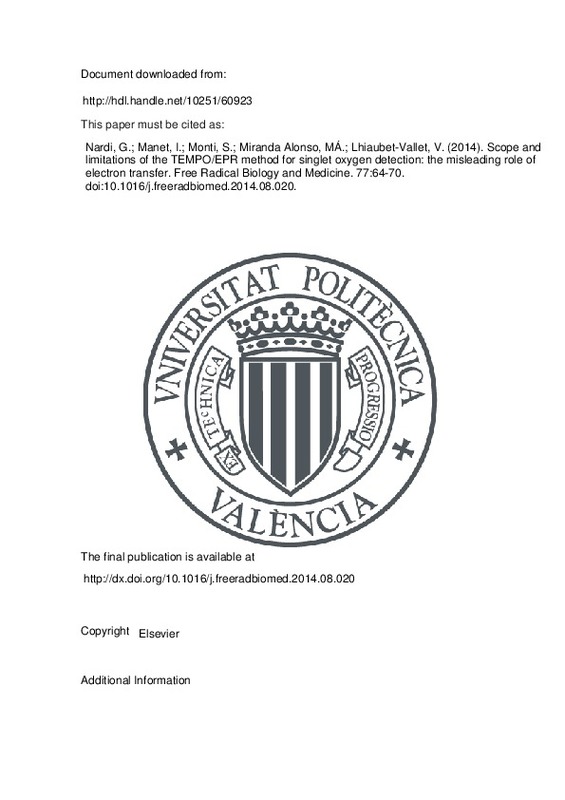JavaScript is disabled for your browser. Some features of this site may not work without it.
Buscar en RiuNet
Listar
Mi cuenta
Estadísticas
Ayuda RiuNet
Admin. UPV
Scope and limitations of the TEMPO/EPR method for singlet oxygen detection: the misleading role of electron transfer
Mostrar el registro sencillo del ítem
Ficheros en el ítem
| dc.contributor.author | Nardi, Giacomo
|
es_ES |
| dc.contributor.author | Manet, Ilse
|
es_ES |
| dc.contributor.author | Monti, Sandra
|
es_ES |
| dc.contributor.author | Miranda Alonso, Miguel Ángel
|
es_ES |
| dc.contributor.author | Lhiaubet-Vallet, Virginie
|
es_ES |
| dc.date.accessioned | 2016-02-16T08:25:48Z | |
| dc.date.available | 2016-02-16T08:25:48Z | |
| dc.date.issued | 2014-12 | |
| dc.identifier.issn | 0891-5849 | |
| dc.identifier.uri | http://hdl.handle.net/10251/60923 | |
| dc.description.abstract | For many biological and biomedical studies, it is essential to detect the production of O-1(2) and quantify its production yield. Among the available methods, detection of the characteristic 1270-nm phosphorescence of singlet oxygen by time-resolved near-infrared (TRNIR) emission constitutes the most direct and unambiguous approach. An alternative indirect method is electron paramagnetic resonance (EPR) in combination with a singlet oxygen probe. This is based on the detection of the TEMPO free radical formed after oxidation of TEMP (2,2,6,6-tetramethylpiperidine) by singlet oxygen. Although the TEMPO/EPR method has been widely employed, it can produce misleading data. This is demonstrated by the present study, in which the quantum yields of singlet oxygen formation obtained by TRNIR emission and by the TEMPO/EPR method are compared for a set of well-known photosensitizers. The results reveal that the TEMPO/EPR method leads to significant overestimation of singlet oxygen yield when the singlet or triplet excited state of the photosensitizer is efficiently quenched by TEMP, acting as electron donor. In such case, generation of the TEMP+(center dot) radical cation, followed by deprotonation and reaction with molecular oxygen, gives rise to an EPR-detectable TEMPO signal that is not associated with singlet oxygen production. This knowledge is essential for an appropriate and error-free application of the TEMPO/EPR method in chemical, biological, and medical studies. | es_ES |
| dc.description.sponsorship | The Spanish government (CTQ2012-32621, RyC-2007-00476, PFIS FI09/00312, Severo Ochoa Program SEV-2012-0267), the Carlos III Institute of Health (Grant RIRAAF, RETICS Program RD12/0013/0009), and the Generalitat Valenciana (Prometeo II/2013/005) are gratefully acknowledged for financial support. Dr. A. Vidal-Moya is acknowledged for his help with the EPR measurements. | en_EN |
| dc.language | Inglés | es_ES |
| dc.publisher | Elsevier | es_ES |
| dc.relation.ispartof | Free Radical Biology and Medicine | es_ES |
| dc.rights | Reserva de todos los derechos | es_ES |
| dc.subject | EPR | es_ES |
| dc.subject | Photosensitizer | es_ES |
| dc.subject | Singlet oxygen | es_ES |
| dc.subject | TEMPO | es_ES |
| dc.subject | Time-resolved near-infrared emission | es_ES |
| dc.subject | Free radicals | es_ES |
| dc.subject.classification | QUIMICA ORGANICA | es_ES |
| dc.title | Scope and limitations of the TEMPO/EPR method for singlet oxygen detection: the misleading role of electron transfer | es_ES |
| dc.type | Artículo | es_ES |
| dc.identifier.doi | 10.1016/j.freeradbiomed.2014.08.020 | |
| dc.relation.projectID | info:eu-repo/grantAgreement/MINECO//CTQ2012-32621/ES/FOTOQUIMICA DE LA FORMACION Y REPARACION DE LESIONES BIPIRIMIDINICAS DE TIPO (6-4), DEWAR Y ESPORA/ / | es_ES |
| dc.relation.projectID | info:eu-repo/grantAgreement/MINECO//RD12%2F0013%2F0009/ | es_ES |
| dc.relation.projectID | info:eu-repo/grantAgreement/GVA//PROMETEOII%2F2013%2F005/ES/ESPECIES FOTOACTIVAS Y SU INTERACCION CON BIOMOLECULAS/ | es_ES |
| dc.relation.projectID | info:eu-repo/grantAgreement/MICINN//FI09%2F00312/ES/FI09%2F00312/ | es_ES |
| dc.relation.projectID | info:eu-repo/grantAgreement/MEC//RYC-2007-00476/ES/RYC-2007-00476/ | es_ES |
| dc.relation.projectID | info:eu-repo/grantAgreement/MINECO//SEV-2012-0267/ES/SEV-2012-0267/ | es_ES |
| dc.rights.accessRights | Abierto | es_ES |
| dc.contributor.affiliation | Universitat Politècnica de València. Instituto Universitario Mixto de Tecnología Química - Institut Universitari Mixt de Tecnologia Química | es_ES |
| dc.contributor.affiliation | Universitat Politècnica de València. Departamento de Química - Departament de Química | es_ES |
| dc.description.bibliographicCitation | Nardi, G.; Manet, I.; Monti, S.; Miranda Alonso, MÁ.; Lhiaubet-Vallet, V. (2014). Scope and limitations of the TEMPO/EPR method for singlet oxygen detection: the misleading role of electron transfer. Free Radical Biology and Medicine. 77:64-70. https://doi.org/10.1016/j.freeradbiomed.2014.08.020 | es_ES |
| dc.description.accrualMethod | S | es_ES |
| dc.relation.publisherversion | http://dx.doi.org/10.1016/j.freeradbiomed.2014.08.020 | es_ES |
| dc.description.upvformatpinicio | 64 | es_ES |
| dc.description.upvformatpfin | 70 | es_ES |
| dc.type.version | info:eu-repo/semantics/publishedVersion | es_ES |
| dc.description.volume | 77 | es_ES |
| dc.relation.senia | 280451 | es_ES |
| dc.identifier.eissn | 1873-4596 | |
| dc.contributor.funder | Generalitat Valenciana | es_ES |
| dc.contributor.funder | Ministerio de Economía y Competitividad | es_ES |







![[Cerrado]](/themes/UPV/images/candado.png)

